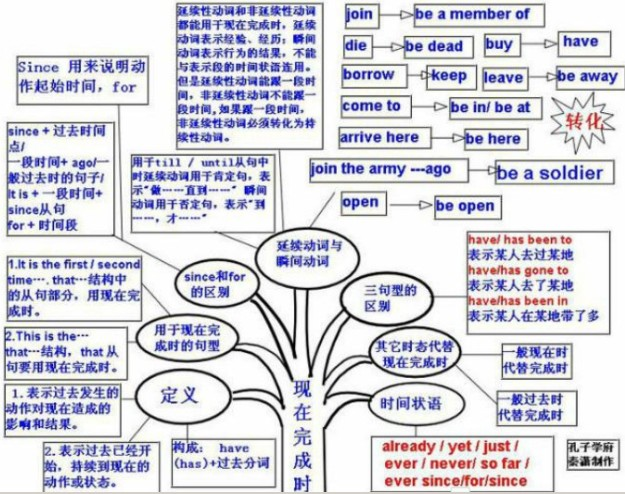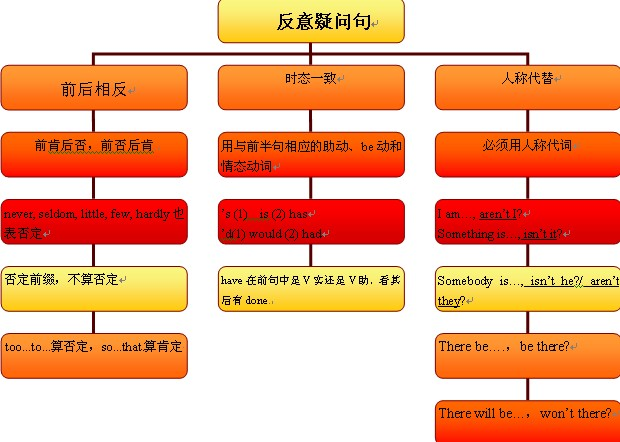本试题 “So far, he must have achieved his goal, ?[ ]A. mustn't heB. didn't heC. doesn't heD. hasn't he” 主要考查您对现在完成时
反意疑问句
等考点的理解。关于这些考点您可以点击下面的选项卡查看详细档案。
- 现在完成时
- 反意疑问句
现在完成时的概念:
现在完成时用来表示之前已发生或完成的动作或状态,其结果的影响现在还存在;也可表示持续到现在的动作或状态。其构成:have(has)+过去分词。
现在完成时共有四种主要用法:
一、现在完成时表示影响:
该用法的现在完成时表示一个过去发生的动作在过去已经完成,并且这个过去发生并完成的动作对现在有影响或结果,同时说话者强调的或感兴趣的就是这个影响或结果,如汉语说“他已离开这个城市了”,其中的“离开”肯定发生了,它对现在的影响或结果就是“他现在已不在这个城市了”;又如汉语说“有人把窗户打破了”,显然“打破窗户”这一动作发生在过去,并且在过去已经完成了,但说话人强调的重点是打破窗户对现在的影响—窗户现在仍是破的。
如:He has left the city. 他已离开这个城市。(结果:他不在这个城市。)
Someone has broken the window. 有人把窗户打破了。(结果:窗户仍破着。)
I have lost my pen. 我把钢笔丢了。(结果:我现在无钢笔用。)
He has finished his work. 他把工作做完了。(结果:他现在可以做其他的事了。)
二、现在完成时表示持续:
该用法的现在完成时表示一个过去发生的动作或开始的状语在过去并未完成或结束,而是一直持续到现在,并且有可能继续下去(也可能到此结束),如汉语说“他在我们学校教书已有30年了”,显然“他在我们学校教书”是从30年前开始,并且一直教到现在,已经持续了30年;又如汉语说“自上个星期以来他一直很忙”,显然“忙”是从上个星期开始的,并且这一“忙”就一直忙到现在。
如:He has taught in our school for 30years. 他在我们学校教书已有30年了。
He has been busy since last week. 自上个星期以来他一直很忙。
He has worked for us ever since he left school. 他离开学校以后就一直为我们工作。
三、现在完成时表示重复:
即表示从过去某个时间直到现在的这个时间范围内不断重复发生的动作或情况,并且这个不断重复的动作有可能继续下去,也有可能到现在就结束。
如:How often have you seen her? 你隔多少见她一次?
My father has always gone to work by bike. 我父亲一向骑车上班。
四、现在完成时表示将来:
同一般现在时可以表示将来一样,现在完成时也可以在时间状语从句里表示将来。
如:I'll wait until he has written his letter. 我愿等到他把信写完。
When you have rested, I'll show you the garden. 等你休息好之后,我领你看我们的花园。
现在完成时知识体系:

比较一般过去时与现在完成时:
1)一般过去时表示过去某时发生的动作或单纯叙述过去的事情,强调动作;现在完成时为过去发生的,强调过去的事情对现在的影响,强调的是影响。
2)一般过去时常与具体的时间状语连用,而现在完成时通常与模糊的时间状语连用,或无时间状语。一般过去时的时间状语:yesterday, last week,…ago, in1980, in October, just now等,皆为具体的时间状语。现在完成时的时间状语:for, since, sofar, ever, never, just, yet, till/until, up to now, in past years,always等,皆不确定的时间状语。共同的时间状语:this morning, tonight, this April, now, already, recently, lately等。
3)现在完成时可表示持续到现在的动作或状态,动词一般是延续性的,如live, teach, learn, work, study, know。一般过去时常用的非持续性动词有come, go, leave, start, die, finish, become, get married等。
例如:I saw this film yesterday.(强调看的动作发生过了)
I have seen this film.(强调对现在的影响,电影的内容已经知道了)
Why did you get up so early?(强调起床的动作已发生过了)
Who hasn't handed in his paper?(强调有卷子未交,疑为不公平竞争)
He has been in the League for three years.(在团内的状态可延续)
He has been a League member for three years.(是团员的状态可持续)
句子中如有过去时的时间副词(如yesterday, last, week, in1960)时,不能使用现在完成时,要用过去时。
(错)Tom has written a letter to his parents last night.
(对)Tom wrote a letter to his parents last night.
反意疑问句的概念:
表示提问人的看法,没有把握,需要对方证实。
反意疑问句由两部分组成:前一部分是一个陈述句,后一部分是一个简短的疑问句,两部分的人称时态应保持一致。
1、陈述部分肯定式+疑问部分否定式,可记为前肯后否。
2、陈述部分否定式+疑问部分肯定式,可记为前否后肯。
例如:This pencil is red, isn't it? Yes, it is. / No, it isn't.
This pencil isn't red, is it? Yes, it is. / No, it isn't.
反意疑问句类型:
1)陈述部分的主语是I,疑问部分要用aren't I.
如:I'm as tall as your sister, aren't I?
2)陈述部分的谓语是wish,疑问部分要用may+主语。
如:I wish to have a word with you, may I?
3)陈述部分用no, nothing, nobody, never, few, seldom, hardly, rarely, little等否定含义的词时,疑问部分用肯定含义。
如:The Swede made no answer, did he/she?
Some plants never blown(开花), do they?
4)含有oughtto的反意疑问句,陈述部分是肯定的,疑问部分用shouldn't/oughtn't+主语。
如:He ought to know what to do,oughtn't he?/shouldn't he?
5)陈述部分有have to+v.(had to+v.),疑问部分常用don't+主语(didn't+主语)。
如:We have to get there at eight tomorrow, don't we?
6)陈述部分的谓语是usedto时,疑问部分用didn't+主语或usedn't+主语。
如:He used to take pictures there, didn't he?/usedn't he?
7)陈述部分有had better+v. 疑问句部分用hadn't you?
如:You'd better read it by yourself, hadn't you?
8)陈述部分有would rather+v.,疑问部分多用wouldn't+主语。
如:He would rather read it ten times than recite it, wouldn't he?
9)陈述部分有You'd like to+v.疑问部分用wouldn't+主语。
如:You'd like to go with me, wouldn't you?
10)陈述部分有must的疑问句,疑问部分根据实际情况而定。
如:He must be a doctor, isn't he?
You must have studied English for three years, haven't you?/didn't you?
He must have finished it yesterday, didn't he?
反意疑问句用法总结:
| 陈述部分的谓语 | 疑问部分 |
| I' | aren’t I |
| wish | may + 主语 |
| no, nothing, nobody, never, few, seldom, hardly, rarely, little等否定含义的词 | 肯定含义 |
| ought to(肯定的) | shouldn't/ oughtn't +主语 |
| have to+v.(had to+v.) | don't +主语(didn't +主语) |
| used to | didn't +主语或 usedn't +主语 |
| had better + v. | hadn't you |
| would rather + v. | wouldn't +主语 |
| you'd like to + v. | wouldn't +主语 |
| must | 根据实际情况而定 |
| 感叹句中 | be +主语 |
| neither…nor, either…or 连接的并列主语 | 根据其实际逻辑意义而定 |
| 指示代词或不定代词everything, that, nothing, this | 主语用it |
| 并列复合句 | 谓语根据邻近从句的谓语而定 |
| 定语从句,宾语从句的主从复合句 | 根据主句的谓语而定 |
| think, believe, expect, suppose, imagine等引导 | 与宾语从句相对应的从句 |
| everybody, anyone, somebody, nobody, no one | 复数they, 单数he |
|
情态动词dare或need dare, need 为实义动词 |
need (dare ) +主语 do +主语 |
|
省去主语的祈使句 Let's 开头的祈使句 |
will you?shall we? |
| there be | 相应的谓语动词+there(省略主语代词) |
| 否定前缀不能视为否定词 | 仍用否定形式 |
| must表"推测" | 根据其推测的情况来确定反意疑问句 |
反意疑问句特殊用法点拨:
1、感叹句中,疑问部分用be+主语。
如:What colours, aren't they?
What a smell, isn't it?
2、陈述部分由neither...nor, either...or 连接的并列主语时,疑问部分根据其实际逻辑意义而定。
如:Neither you nor I am engineer, are we?
3、陈述部分主语是指示代词或不定代词everything, that, nothing, this,疑问部分主语用it。
如:Everything is ready, isn't it?
4、陈述部分为主语从句或并列复合句,疑问部分有三种情况:
a.并列复合句疑问部分,谓语动词根据邻近从句的谓语而定。
如:Mr. Smith had been to Bei jing for several times, he should have been in China now, shouldn't he?
b.带有定语从句,宾语从句的主从复合句,疑问部分谓语根据主句的谓语而定。
如:He is not the man who gave us a talk, is he?
He said he wanted to visit Japan, didn't he?
c.上述部分主句谓语是think, believe, expect, suppose, imagine等引导的定语从句,疑问部分与宾语从句相对应构成反意疑问句。
如:I don't think he is bright, is he?
We believe she can do it better, can't she?
5、陈述部分主语是不定代词everybody, anyone, somebody, nobody, noone等,疑问部分常用复数they,有时也用单数he。
如:Everyone knows the answer, don't they?(doeshe?)
Nobody knows about it, do they?(doeshe?)
6、带情态动词dare或need的反意疑问句,疑问部分常用need(dare)+主语。
如:We need not do it again, need we?
He dare not say so,dare you? 当dare, need为实义动词时,疑问部分用助动词do+主语。
如:She doesn't dare to go home alone, does she?
7、省去主语的祈使句的反意疑问句,疑问部分用will you。
如:Don't do that again, will you?
Go with me, will you/won't you? 注意:Let's开头的祈使句,后用shall we? Let us开头的祈使句,后用will you?
如:Let's go and listen to the music, shall we?
Let us wait for you in the reading-room, will you?
8、陈述部分是"therebe"结构的,疑问部分用there省略主语代词。
如:There is something wrong with your watch, isn't there?
There will not be any trouble, will there?
9、否定前缀不能视为否定词,其反意疑问句仍用否定形式。
如:It is impossible, isn't it?
He is not unkind to his classmates, is he?
10、must在表"推测"时,根据其推测的情况来确定反意疑问句。
如:He must be there now, isn't he?
It must be going to rain tomorrow, won't it?
反意疑问句知识体系:

复合句的反意疑问句:
1、当陈述部分是一个(带that引导宾语从句的)主从复合句时,附加疑问句的主谓要和主句的主谓保持对应关系。但是,当陈述部分的主语是:I suppose, I think, I believe, I imagine, I expect等结构时,附加疑问句的主语和谓语要和从句的主语,谓语保持一致关系。而且要注意到否定的转移问题。
如:I think there is something wrong with the washer, isn't there?
We don't suppose he cares, does he?
2、当陈述部分是I'm sure that;we are sure;I'm afraid that;We are sure that;I feel sure that等后面跟宾语从句时,反意疑问句与后面的宾语从句一致。
3、当陈述部分是并列句时,附加疑问句的主谓语要和离它最近的句子的主谓保持对应关系。
如:We must redouble our efforts, or we'll not be able to catch up with the others, will we?
与“So far, he must have achieved his goal, ?[ ]A. mustn't he...”考查相似的试题有:
- — Oh , it is already 9:00, but Tom is still in bed.— He ______ late last night to watch the football match.[ ]A. may ...
- —I ________ my son to Laos for sightseeing.—I would rather you didn't do that,for the bird flu ________ several live...
- Those who ____ in ____compositions, please hand them in this afternoon.[ ]A. hasn’t handed; hisB. haven’t handed; the...
- —Where _______?—I got caught in the traffic, or I would have been here sooner.A.did you goB.had you goneC.have you...
- I think he has tried his best to improve his handwriting, ?A.don’t IB.do IC.hasn’t heD.has he
- It's the first overseas trip that President Hu Jingtao has made this year,_______?[ ]A. is itB. isn't itC. has heD. h...
- It was Alice and her husband who sent the old man to the hospital, _______?[ ]A. wasn’t itB. didn’t theyC. don’t they...
- It's the first time that he has been to Australia, _____?A. isn't heB. hasn't heC. isn't itD. hasn't it
- —Nothing wrong with it , ?—No .Yours is a specially-built model. Drive carefully , though .It takes time to run in a ...
- I told them not everybody could run as fast as you did, _____?A. could he B. didn’t I C. didn’t you D. could they